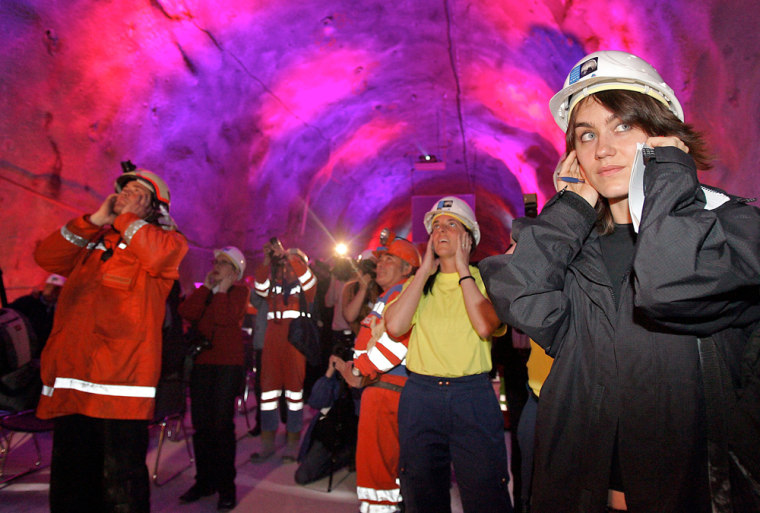Swiss engineers on Thursday blasted through the final four yards of rock to complete the bore of the first of two deep rail tunnels under the Swiss Alps linking north and south Europe.
The 21-mile Loetschberg tunnel, part of a massive construction project to move heavy European Union trucks off Switzerland’s narrow highways and onto transport trains, will shorten the travel time between Germany and Milan, Italy, by an hour.
An engineer blew three warning blasts on a horn, and an explosion ripped through the final section of rock — as about 1,000 guests watched in the tunnel adorned with blue and red beams of light.
As a traditional Alphorn played a mountain melody, workmen in hard hats greeted each other, waving the Swiss flag and sharing bottles of wine.
‘We are moving on’
“With the breakthrough we have carved out the mountain for all to see. We are moving on,” said Moritz Leuenberger, Switzerland’s transport minister.
The Loetschberg is expected to begin passenger and freight transport in 2007. The parallel 36-mile Gotthard Tunnel, which will be the world’s longest, is not scheduled for completion for at least another decade.
Switzerland is at the center of a north-south European axis where traffic has increased more than tenfold since 1980. The Swiss have tired of traffic jams caused by big rigs and vacationers clogging their tunnels.
The final excavation was at the midpoint of the tunnel, some 5,900 feet underneath the Balmhorn mountain on the border between Bern and Valais states. Drilling for the Loetschberg began in 1994 at Mitholz, near its northern end about 35 miles south of the Swiss capital of Bern.
Almost perfect calculation The two halves of the tunnel met almost perfectly: the center of the bore coming from the north was only 5 inches off the center of the bore coming from the south and their heights were mere fractions of an inch off.
On completion, the Loetschberg tunnel will be the longest under the Alps and the third-longest in the world, behind only Japan’s 33.5-mile Seikan and the 31.3-mile English Channel Tunnel. It will allow freight trains to travel at speeds of more than 100 mph and passenger trains at 150 mph.
The final cost for the Loetschberg will be about $3.5 billion, almost $840 million more than originally budgeted. For the combined project, the budget has now escalated to around $13.7 billion, more than $3 billion over the original estimate.
To dig the Loetschberg, some 16 tons of explosives were used and enough rock was excavated to pack a freight train 2,500 miles long — stretching across Europe from Lisbon, Portugal, to Helsinki, Finland.
